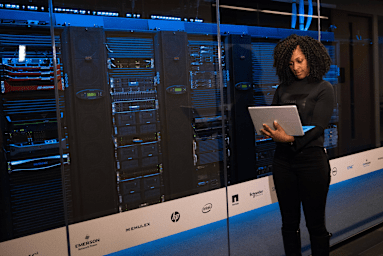
Interactive
Interconnecting Cisco Networking Devices (CCENT), Part 2 of 4: Internet Connectivity
Biz Library
Updated Feb 04, 2020Interconnecting Cisco Networking Devices Part 1 is the exam associated with the Cisco Certified Entry Network Technician (CCENT) certification or the first half of the Cisco Certified Network Associate Routing and Switching (CCNA Routing and Switching). This course is about establishing internet connectivity. Topics covered include: understanding internet layers and protocols, IP addressing, broadcast domains, relaying packets, use of the Cisco discovery protocol, static routing, access control lists and traffic handling as well as using network address translation.
Lesson 1:
- IP
- Breaking Down the IPv4 Address
- IP Header
- Number Systems
- Base X Number System
- Conversion to Binary
- IPv4 Address Classes
- Distributing Addresses
- Reserved IPv4 Addresses
- What Is DNS
- Summary.
Lesson 2:
- Broadcast Domains
- Why Subnets
- Using a Subnet Mask
- Subnet Mask Values
- Subnet Masks and Classful Addresses
- Default Gateways
- Host and Subnet Combinations for Class B
- Subnet Mask Procedures
- Network Addressing Scheme
- Network Addressing Scheme Continued
- Second Example of Network Addressing Scheme
- Results of Network Address Schemes
- Third Example of Network Addressing Scheme
- Variable Length Subnet Masking
- VSLM Continued
- VLSM Scenario
- VSLM Scenario Continued
- Summary.
Lesson 3:
- Understanding the TCP/IP Transport Layer
- Reliability
- Comparing TCP and UDP
- UDP Characteristics
- The UDP Header
- TCP Characteristics
- TCP
- TCP/IP Application Layer
- TCP 3-Way Handshake
- Summary.
Lesson 4:
- Configure Cisco Router
- Initial Router Setup
- Router Configurations
- Router Configurations Continued
- Cisco Discovery Protocol
- CDP Continued
- Show CDP Details
- LLDP
- LLDP Limitations
- LLDP Benefits
- Summary.
Lesson 5:
- The Demarcation Point
- What Is DHCP
- IP Address Allocations
- Service Provider Options
- Configuring the Router as a DHCP Client
- RFC 1918 Private Addresses
- What is NAT?
- NAT Address Types
- Example of NAT
- Types of NAT
- Static NAT
- Static NAT Configuration
- Verifying Static NAT
- Dynamic NAT
- Verifying Dynamic NAT
- What Is PAT
- Configuring PAT.
Lesson 6:
- Troubleshooting NAT
- Troubleshooting NAT Continued
- Troubleshooting Scenario
- Troubleshooting Scenario Continued
- Provider-Assigned IP Addresses
- Demo: Branch Router Setup
- Demo: Configure Branch Router
- Demo: Navigating the CLI.
Lesson 7:
- Demo: Attempting to Connect to the Internet
- Demo: Successful Connection
- Demo: NAT Assignment
- Demo: Set up NAT Pool
- Demo: PAT
- Demo: The Life of a Packet
- Demo: Routers vs. Switches.
Lesson 8:
- Routing Operations
- Routing Operations Continued
- Static Route
- Configure a Static Route
- Configure a Static Route Continued
- Default Routes
- Verify Static Routes
- Verify Static Routes Continued
- Gateway of Last Resort
- Summary.
Lesson 9:
- Summary
- Types of Protocols
- The Role of a Router
- Router Components
- Function of the Router
- Best Path Determination
- The Routing Table
- How Routes Are Learned
- Routing Protocols.
Lesson 10:
- Types of ACLs Continued
- ACLs
- Wildcard Masking Continued
- Basic ACL Configuration Continued
- Basic ACL Configuration
- How an ACL Operates
- Types of ACLs
- Wildcard Masking
- Summary.
Lesson 11:
- More Host-to-Host Packet Delivery
- Host-to-Host Packet Delivery Continued
- What the Switch Does
- What Is ARP
- Layer 3 Addressing
- Ethernet Addressing
- Summary
- Host-to-Host Packet Delivery.







